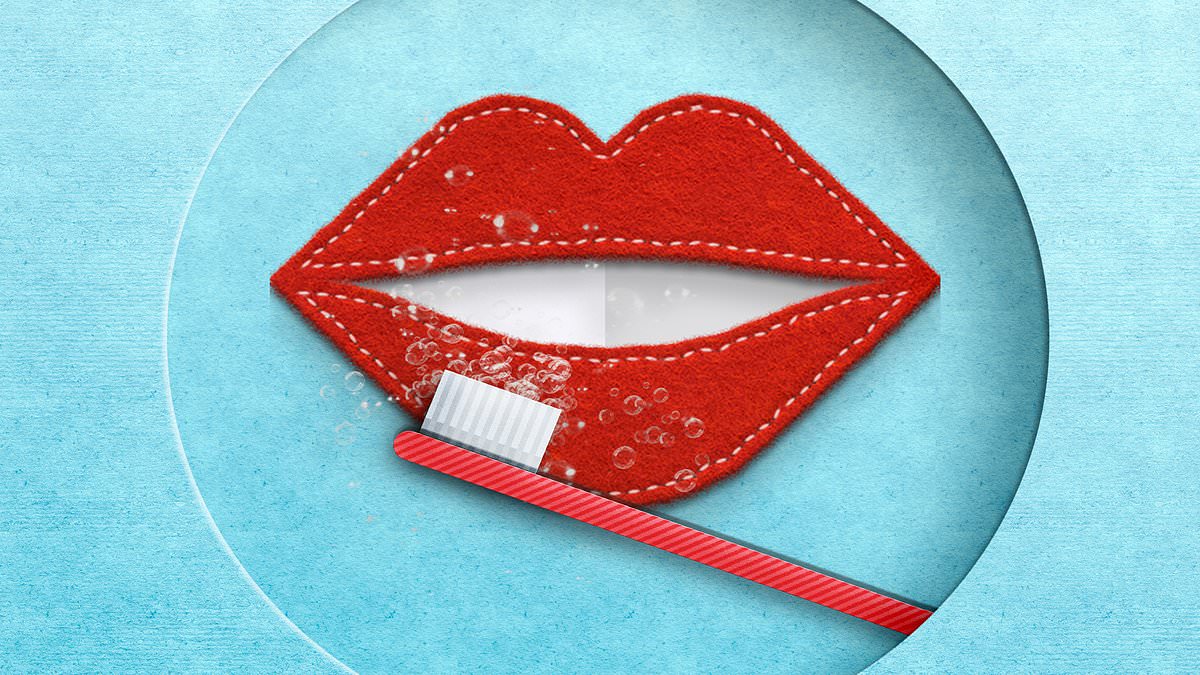One of my biggest regrets is that I didn’t look after my teeth when I was younger. Growing up I ate a lot of sugary snacks and because of that, most of my teeth have had to be drilled and filled over the years — both painful and expensive.
I know first-hand how much pain and distress tooth decay can cause and my heart goes out to all those struggling to find a dentist (a survey last year found that 90 per cent of dental practices in the UK were refusing new adult NHS patients) or who are resorting to DIY dentistry or going abroad.
Though it’s a bit late in the day, I’m still keen to look after what’s left of my teeth — and in fact there’s a lot you can do to keep them strong and free from decay, whatever your age.
It’s not just about the appearance of teeth — looking after your teeth matters because there’s mounting evidence that the bacteria that lurk in inflamed gums can break off, get into your blood, spread and cause inflammation in other parts of your body and brain.
That is why gingivitis (inflamed gums) is strongly linked to an increased risk of heart disease and dementia.

A survey last year found that 90 per cent of dental practices in the UK were refusing new adult NHS patients
A study by Boston University last year showed that, in mice, when bacteria from inflamed gums reach the brain they are attacked and devoured by white cells, called microglia, which protect our brain from invaders. But like sleepy guard dogs that have gorged on a large piece of meat, those white cells are then too ‘full’ of dental
bacteria to actively seek out and destroy harmful plaque in the brain which seems to drive Alzheimer’s disease.
So to protect your teeth, brain and other vital organs, the most obvious place to start is with brushing your teeth.
As everyone knows, the advice is to use toothpaste, twice a day, that contains fluoride: this protects the enamel on your teeth against the acid-making bacteria, which are the main cause of cavities and gum disease. Starting in Birmingham in 1964, fluoride has been added to UK water supplies in the hope of reducing tooth decay.
But progress is slow and only about 10 per cent of the population have access to fluoridated water — which could partly explain why we have such terrible teeth.
The Government has announced ambitious plans to add fluoride to the drinking water in the rest of the country, starting in the North East. This is something that has been resisted in the past by those who, I think wrongly, believe that doing so could affect children’s mental health and cause problems such as ADHD.
You can also reap the benefits of fluoride by massaging some fluoride toothpaste into your gums after lunch. That was the conclusion of a study by the University of Gothenburg in Sweden, in 2012, which found that doing so increased ‘fluoride protection’ by 400 per cent.
The modern advice regarding when to brush your teeth is more surprising — and goes against what I’ve been doing my entire life: the British Dental Association recommends brushing your teeth before you sit down to eat breakfast, rather that after.
That’s because if you brush your teeth before food, you not only remove bacteria that have built up on your teeth overnight (and which contribute to a dry mouth and morning breath), but the fluoride in the toothpaste will also protect your teeth from the acids in breakfast drinks, such as orange juice and coffee. If you brush your teeth straight after eating, when teeth have been weakened by acid, you can damage the enamel.
As well as brushing, I floss my teeth twice a day. But should you floss before or after brushing?
In a study by Hamadan University of Medical Sciences in Iran in 2015, 35 dental students spent two weeks either flossing before brushing, or the other way round. It turned out that the floss-then-brush approach removed much more plaque.
And it’s not just about passing floss between teeth — the right way to floss is to take a piece between each space, scraping it against the sides of each tooth in turn, to clean away any build-up. And finally, once you have flossed and then brushed your teeth, don’t rinse your mouth — that would wash away the fluoride, which is better left to coat your teeth.
Certain foods can also help keep your teeth in good shape.
I eat plenty of cheese, milk and yoghurt, because as well as being delicious they are a good source of calcium, which helps protect and rebuild your tooth enamel.
Studies have also shown that cheese is a great saliva generator (it’s unclear why) and saliva can neutralise acid on teeth which would otherwise promote decay.
An apple a day, particularly if eaten after a meal, really could also keep the dentist away — if you eat the skin. That’s because the fibrous peel will help scrape away some of the plaque and food debris left after eating.
Avoid sugary drinks and instead knock back water, which improves saliva flow, or tea which is rich in compounds called polyphenols that help suppress the growth of acid-producing bacteria in your mouth. Also cut down on sugary snacks. (However, I was surprised to learn that raisins — despite being sugary — also contain a substance that kills acid-producing bacteria on teeth.)
If you’re going to have a sweet treat, then it’s best at the end of a meal, or devoured all in one go!
Wearing a fitness tracker on your wrist to monitor your steps, heart rate and sleep is common these days. But now researchers at Washington State University have gone one further, with ‘smart earrings’ that track your body temperature via your ear lobes.
They suggest tracking body temperature this way could tell doctors how well a patient with a fever is responding to antibiotics, or let a woman know when she’s ovulating and at her most fertile (her body temperature rises by a fraction of a degree).
The researchers want to develop more trackers that can double as jewellery, including a necklace to detect irregular heartbeats. The ideal birthday present, perhaps.
Could doing the plank help control blood pressure?
After reading a study that said we lose around 5 per cent of our muscle mass every year from age 30 (unless we do something about it), I have been doing squats and pressups every morning.
I normally manage at least 30 of each, though it never gets easier. And I’ve now added another type of exercise to my morning routine: the plank.
Recent research suggests that isometric exercise — which involves holding your body stationary in one position for a certain time (e.g. the plank) — helps keep blood pressure in the healthy range, something I am keen on as I have a family history of strokes.
For a plank, you balance on your elbows, with your feet on the ground straight behind you: then hold that position for 30 seconds or so. It’s important you check how to do this properly, online or with a fitness coach, before starting.
But how does it help? I asked Dr Jamie O’Driscoll, a researcher in cardiovascular physiology at Canterbury Christ Church University, who recently published a study that showed isometric exercise can lower blood pressure more than other types, such as running.
He thinks it’s probably because isometric exercise increases the tension in muscles when you are holding your body in a fixed position, then causes a sudden rush of blood when you relax, which increases blood flow — and a drop in blood pressure. As well as the plank, Jamie recommended I try the wall squat which has a similar benefit.
Here, you lean your back against a wall and then slowly slide down, as if you are about to sit on a chair. When your knees are bent at a 90-degree angle, or it starts feeling uncomfortable, you maintain that position for 30 seconds or so.
I found this was too uncomfortable so I gave up, but I think the plank is working: my blood pressure, while it was already in the healthy range, is definitely creeping down.
I’ve just started a UK tour, sharing tips on how to sleep better and eat healthily, but despite my experience on TV, I’m finding live shows stressful.
One of the best ways to help me deal with such stress is to reframe the situation as a challenge, rather than a threat. And a recent study by the University of Bath suggests that doing this will reduce the risk of mental health problems and of illnesses such as flu.
So before I go on stage, I tell myself that the surge in my heart rate is the result of excitement, rather than fear. So far it seems to be working. If you fancy coming along and saying hello, go to michaelmosley.co.uk/live








